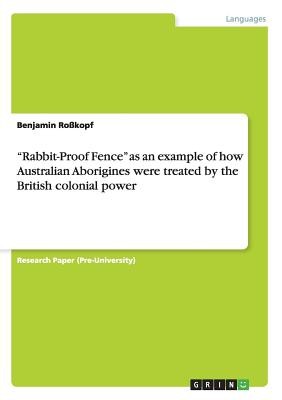
- We will send in 10–14 business days.
- Author: Benjamin RoÃkopf
- Publisher: GRIN Publishing
- ISBN-10: 3656820961
- ISBN-13: 9783656820963
- Format: 14.8 x 21 x 0.2 cm, minkšti viršeliai
- Language: English
- SAVE -10% with code: EXTRA
Rabbit-Proof Fence as an example of how Australian Aborigines were treated by the British colonial power (e-book) (used book) | bookbook.eu
Reviews
Description
Pre-University Paper from the year 2009 in the subject English - Miscellaneous, grade: 13 Punkte, language: English, abstract: During the years 1910 and 1970 up to 100,000 Aboriginal children were taken forcibly from their families by police or welfare officers, because of a Federal and State Government edict. The main motive was to 'assimilate' Aboriginal children into European society over one or two generations by denying and destroying their Aboriginality. This issue is also discussed in the novel "Rabbit-Proof Fence" by Doris Pilkington, which tells a story about three girls who were also uprooted from their community and taken to a state settlement about 1,500 miles away from their home. In this reality-based story the girls escaped from their internment camp and tried to run back home by following the rabbit-proof fence. My term paper is divided into four chapters. In the first one a short outline of British colonisation in Australia and its impacts on the Aborigines will be given. The second chapter is about the mentioned book and its author and the third part of this term paper analyses some extracts from Doris Pilkington's novel and proves their verity with historical documents until it finally comes to its conclusion in the last chapter which tells us something about the current situation of the Aborigines and the reactions of the Australian government.
EXTRA 10 % discount with code: EXTRA
The promotion ends in 22d.10:21:29
The discount code is valid when purchasing from 10 €. Discounts do not stack.
- Author: Benjamin RoÃkopf
- Publisher: GRIN Publishing
- ISBN-10: 3656820961
- ISBN-13: 9783656820963
- Format: 14.8 x 21 x 0.2 cm, minkšti viršeliai
- Language: English English
Pre-University Paper from the year 2009 in the subject English - Miscellaneous, grade: 13 Punkte, language: English, abstract: During the years 1910 and 1970 up to 100,000 Aboriginal children were taken forcibly from their families by police or welfare officers, because of a Federal and State Government edict. The main motive was to 'assimilate' Aboriginal children into European society over one or two generations by denying and destroying their Aboriginality. This issue is also discussed in the novel "Rabbit-Proof Fence" by Doris Pilkington, which tells a story about three girls who were also uprooted from their community and taken to a state settlement about 1,500 miles away from their home. In this reality-based story the girls escaped from their internment camp and tried to run back home by following the rabbit-proof fence. My term paper is divided into four chapters. In the first one a short outline of British colonisation in Australia and its impacts on the Aborigines will be given. The second chapter is about the mentioned book and its author and the third part of this term paper analyses some extracts from Doris Pilkington's novel and proves their verity with historical documents until it finally comes to its conclusion in the last chapter which tells us something about the current situation of the Aborigines and the reactions of the Australian government.


Reviews